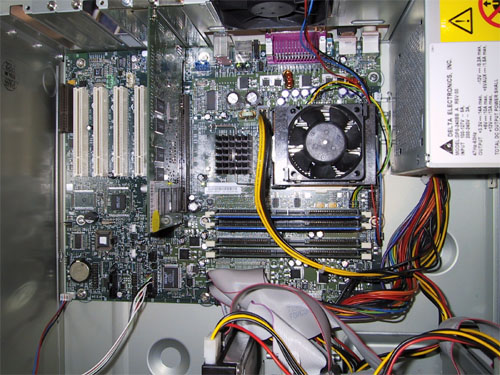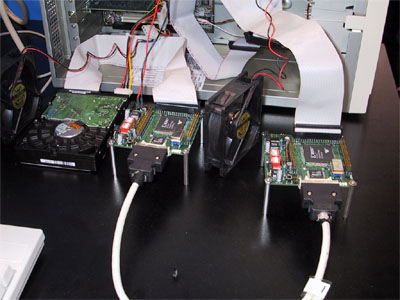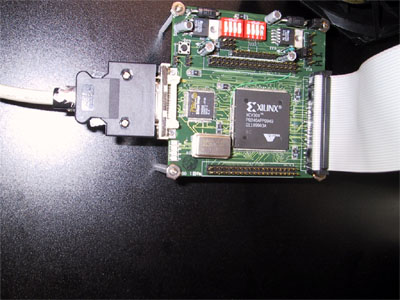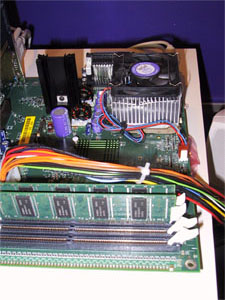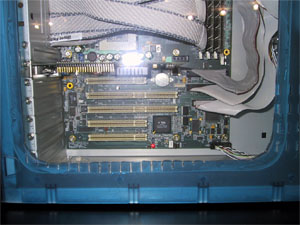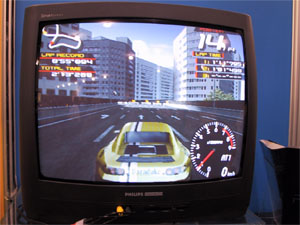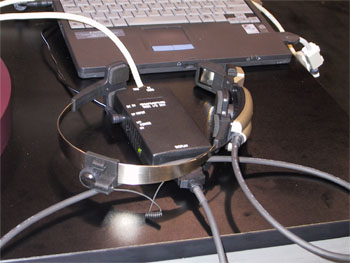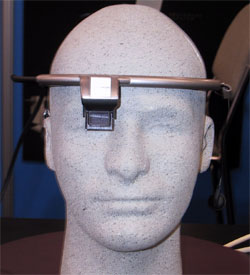
Original Link: https://www.anandtech.com/show/615
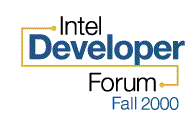 This
year's fall IDF conference put on by Intel turned out to be quite an interesting
show. As usual, the meat of the show consisted of "tracks," grouped
seminars regarding a specific technology. Aimed to inform OEM companies, developers,
and the press of what is going on around Intel and what future technology we
can look forward to, these tracks proved to be very informative as well as interesting.
Since many of you could not be there, we covered exactly what went on at the
tracks we attended at the first two days of the show. You can find our day
1 report here and
our day 2 report here.
In addition, we recently wrote an interesting article about two wireless technology
tracks we attended at the conference which can be found here.
This
year's fall IDF conference put on by Intel turned out to be quite an interesting
show. As usual, the meat of the show consisted of "tracks," grouped
seminars regarding a specific technology. Aimed to inform OEM companies, developers,
and the press of what is going on around Intel and what future technology we
can look forward to, these tracks proved to be very informative as well as interesting.
Since many of you could not be there, we covered exactly what went on at the
tracks we attended at the first two days of the show. You can find our day
1 report here and
our day 2 report here.
In addition, we recently wrote an interesting article about two wireless technology
tracks we attended at the conference which can be found here.
Besides all the key note speeches and the track sessions, IDF is just like any other computer show where companies come to show of their own upcoming and present technologies. As with many shows, IDF has a showroom floor that serves as a place to demonstrate this technology. In the case of IDF, the show floor was open towards the end of the day, when tracks were dying down. It was here that we got to see what interesting stuff companies other than Intel had to show.
Before we take a look at what we saw on the show floor, let's take a look at beautiful San Jose, where IDF was held this fall.
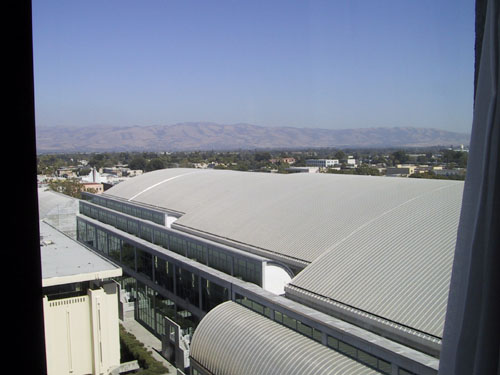
As you can see, this view from the adjacent Hyatt hotel shows that the San Jose convention center is quite large, especially considering the fact that this view only shows about half of the center. Naturally the weather was beautiful, as it tends to be in California.
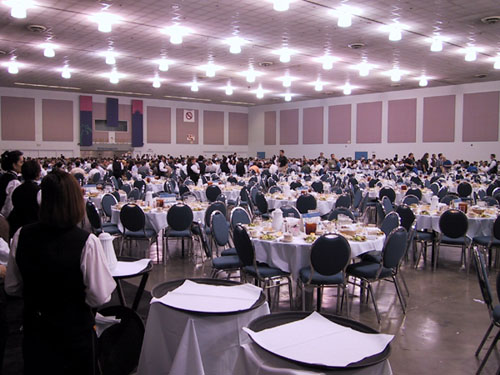
Intel, who had to organize lunch for the 5,000 conference attendees, had quite a task on their hands. The picture above shows the massive dining hall that provided weary conference goers both food and drink.
On the Floor - Intel
Upon entering the show floor, it was quite apparent that many companies were able to make it out to display their technologies at IDF. Although the show space at IDF may not be as large as Comdex for example, there were still quite a few interesting demonstrations. Let's take a look at some of the more impressive ones.
As one would suspect, Intel had quite a presence on the show floor. Not actually on the show floor but rather in a separate room for press only, Intel demonstrated some new technology that they were working on. This display was an interactive demo room, with each of the Intel future products being available for short testing.
On one side of the room, Intel had a demonstration of "computer vision technology," implemented in its simplest form. This demonstration consisted of a series of games, each of which used an Intel web cam to "view" the player and make him or her an interactive part of the game. This allowed, for example, a game to translate a user's motion into actions, allowing the game player to slap the correct answer out of mid air.
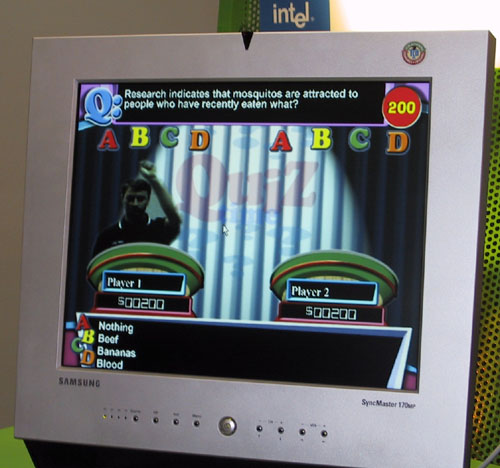
The game actually separates the user from the background in exactly the same manner that more complicated systems use blue screens for. The camera captures an image of the background without the player present and then notes any changes from the background and places them on the screen. Since this type of image processing requires quite a bit of power, the demo we saw was still rather basic, having problems separating the player from the background at times and also requiring quite large "buttons" to push for the correct answer.
At the same press only event, we had an opportunity to look at another evolving technology from Intel. This demonstration allowed a user to control a receiver right from one's computer. Demonstrated in both Linux as well as Windows, the program communicated with the receiver via an attached cable. Intel hopes to integrate this signal in the receiver (or other devices') wall outlet jack, meaning that remote control from one's computer could be achieved simply by plugging a device in. Below is a picture of what Intel had set up.
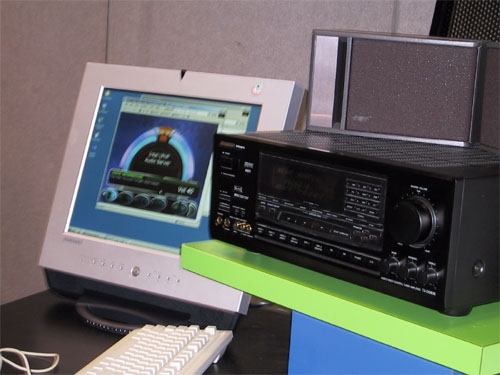
Once we hit the show room floor, we saw some more of Intel's offerings. On the Itanium front, Intel had quite a few servers equipped with Itanium processors inside. Perhaps one of the most interesting displays on the Itanium front came from the Microsoft booth, where a computer was featured running off an Itanium processor on "Windows 2000 Advanced Server, 64-bit Edition," as seen below.
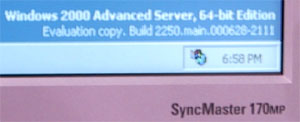
For a final display of power, Intel had, among other things, a Pentium 4 system on display. Note the huge heatsink not only on the processor but also on the i850 memory controller hub. Rumor has it that these pieces get quite hot.
On the Floor - Serial ATA
Located very near the Intel booths was a large section of the floor dedicated to Silicon Image, the company currently working hard on making serial ATA a reality. The demonstrations as well as the presentation were very similar to what we saw at this spring's IDF, as we reported on here. Silicon Image once again demonstrated Serial ATA technology by taking a standard parallel ATA connection found on a motherboard, running it to a dongle of sorts that converted the parallel ATA signal to serial ATA, and then through a cable. This cable then led to another dongle that converted the serial ATA signal back to parallel ATA for use with a normal hard drive. The reason that the setup would have to be this way is due to the fact that there are currently no devices that use serial ATA as of yet. Expect devices to appear once the specification gets finalized later this year.
Here is a picture of what Silicon Image had running in their setup. Note the extremely small cable size for the serial ATA connection, as well as the fans currently cooling the logic on the dongles. Silicon Image said that these fans were most likely unnecessary, but at a show it is better to be safe than sorry.
On the Floor - DDR Galore
One would suspect that with the upcoming launch of the Pentium 4 the memory technology being pushed at this fall's IDF would be RDRAM. The show floor proved to paint quite a different view of the memory technology of the future, with far more DDR memory solutions being presented than RDRAM solutions. Since Intel calls for their upcoming Itanium processor to use DDR memory, manufacturers displaying DDR memory solutions were not booed off the scene. Perhaps the most interesting demonstrations of DDR memory did not involve the Itanium at all, but rather the Pentium III and the Athlon.
Below is an example of one memory manufacturer's DDR SDRAM solution. In this case, Hyundia parts are pictured.
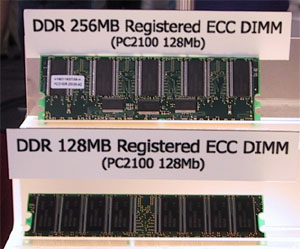
One of the most interesting, as well as exciting thing that we got to see on the IDF floor was found at Hyundia's booth. A mere 15 steps away form the Intel pavilion, Hyundia had a little surprise to show off their DDR SDRAM solution. To show the potential for DDR memory use, as well as show that DDR Athlon boards are sure to be here soon, Hyundia had a prototype AMD 760 based motherboard on display powered by an Athlon "Thunderbird" 1GHz CPU.
As many of you know, the 760 chipset is AMD's next generation chipset that is set to follow up the current 750. Among other changes, this board will feature DDR memory, as one can clearly see with these shots below.
Also on the DDR front, Micron was displaying a prototype motherboard running their Samurai DDR north bridge that was configured in a dual Socket 370 configuration. Although Micron has vowed that they will not be releasing this chipset to the mass market, it was still neat to see the board in action. Too bad it was behind a glass cage.
On the Floor - Other Interesting Stuff and Final Thoughts
While at the show we were also able to see some upcoming technology that can only be described as "cool." Let's take a look at these devices.
First was a new HDTV display with technology based off of Texas Instruments research. This form of HDTV display actually uses a single light source that "draws" the image to the screen via rotating mirrors. The individual mirrors control the color as well as the contrast, with brightness and contrast controls coming from how the mirror is angled. This provides for a perfectly white or black picture, something that is hard to do with LCD based technology. In addition, the costs of these HDTVs are supposed to be significantly less that competing technologies, as only one light source is involved. We got a chance to see this thing up close, and trust us, you will want one of these in your living room, if not every room in the house.
Another thing that we finally got to see in person is the upcoming Playstation 2 that was being demoed in the RDRAM booth. It was nice to not only see the console, which looks rather impressive, but also to play a bit on the game that was being demoed. Too bad we were playing on such a small TV.
Finally, one last "cool" item that we saw was a wearable computer display that used technology made by Colorado Microdisplay. They had two models on display. The first one, pictured below, may look very similar to you TV buffs out there. This is actually the display unit that goes with the IBM wearable PC had quite a successful advertising campaign.
The second, and more attractive model (in our opinion) came from a Japanese company named Shimadzu. This personal display weighs less than 80g and is able to display at 800x600. Having the monocular display so close to the eye, the tiny display is actually equivalent to viewing a 13" monitor from 60 cm away. Not too bad, and it looks pretty cool too.
After trying both of these products, it seems like they would make great toys, if not more. With the price of the Shimadzu piece "below $400," they also seem affordable.
Final Thoughts
Not only was IDF great for leaning about Intel's upcoming products and plans, it also served to introduce us to a whole new world of computer hardware. If the IDF show floor is any indication of what technology is becoming, then the future looks promising.

